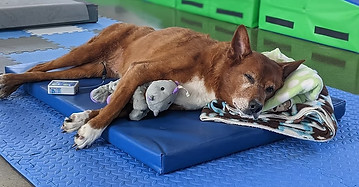
Does my dog need veterinary rehabilitation?
Is your dog....
-
Limping?
-
Sore?
-
A senior?
-
Stiff when rising?
-
Struggling on walks?
Has your dog....
-
Broken a bone?
-
Damaged a joint?
-
Had surgery?
-
Been treated for disc disease?
-
Not improved with rest alone?
Does your dog....
-
Compete in agility?
-
Compete in obedience?
-
Compete in conformation?
-
Need to be fitter?
-
Have arthritis?
How can rehabilitation help my dog?
-
Provide acute or chronic pain relief
-
Reduce healing times
-
Restore strength & muscle mass
-
Improve balance & coordination
-
Improve surgical outcomes
-
Reduce inflammation
-
Increase range of motion
-
Promote joint health
-
Restore function & mobility during the healing process

What conditions benefit from rehabilitation?

-
Hip & elbow dysplasia
-
Neurological conditions
-
Cruciate ligment injury
-
Interveterbral Disc Disease
-
Pre & post surgery
-
Amputees
-
Sport dog injuries
-
Senior dogs
-
Osteoarthritis
-
Tendon sprains
-
Muscle strains
Treatment Options
Manual Therapy
Much like a human physio may do an in appointment, this may include soft tissue mobilisation, myofascial release, joint mobilisation, trigger point release, hot or cold therapy, and passive stretches.
Modalities
The options I provide include Low Level Laser Therapy (Class 3B), Pulsed Electromagnetic Field (PEMF bed), Transcutaneous Electrical Nerve Stimulations (TENS) & Neuromuscular Electrical Stimulation (NMES) and Cycloidal Vibration Therapy. Scroll down for more detailed information on each type.

Theraputic Exercises & Home Exercise Plans
Therapeutic exercises are customised physical activities designed to target specific muscles or conditions. The exercises may focus on things like strengthening weak muscles, improving flexibility, enhancing balance, improving joint stability, improving coordination, addressing muscle activation and enhancing overall movement.
These can include things like passive & active stretches, balance exercises, proprioception exercises, cavaletti, transitions, neuromuscular re-education, strengthening... the list is almost endless. The exercises will be tailored to your individual dogs needs and your abilities. I will show you how to do the exercises with your dog, you will then practice so I can ensure they are being done correctly, and you will go home with detailed instructions so you can work on your dogs Home Exercise Plan yourself between appointments.
Modalities
Low Level Laser Therapy
Laser therapy, also known as Photobiomodulation, is a scientifically proven non-invasive treatment. It is painless and uses waves of light to elicit a photochemical reaction in cells which decreases inflammation, relieves pain, and encourages healing. Laser therapy stimulates cellular metabolism which can help nerve cells regenerate and speed up wound healing. It can also penetrate into deeper tissues including joints, where inflammation can be quite painful.


Pulsed Electromagnetic Field
Every cell in the body has electrically charged particles called ions. When the body is injured or ill, conduction of these ions is negatively affected. PEMF stimulates the cell membrane to get these ions back to normal movement, therefore increasing cellular communication. This in turn increases blood supply, improves cell function, and decreases pain/inflammation. A dog can lie on the PEMF bed and receive this treatment during an exam, or even just whilst relaxing.
TENS & NMES
Transcutaneous Electrical Nerve Stimulation (TENS) and Neuromuscular Electrical Stimulation (NMES), are both forms of electrotherapy that target nerves via a mild electrical current. The primary purpose of TENS is to provide pain relief, whereas NMES is used to treat muscular weakness.
TENS stimulates sensory nerve fibres, so the nerves which normally transmit pain are overridden. The stimulation delivered also activates specific natural pain relief mechanisms.
NMES helps reverse muscle atrophy by painlessly stimulating nerves within specific muscle groups. This causes muscles to repeatedly contract. This in turn increases blood flow to the area, helps strengthen weakened muscles, and can help retrain muscle fibers to respond to the body's normal neurological signals. This can be especially helpful for patients with paralysis as it improves neurological function in those limbs.

Cycloid Vibration Therapy

Cycloid Vibration Therapy (CVT) via the use of a Cannisage bed is a safe and easy treatment used on soft tissue injuries, sore muscles, and joints.
The premise of CVT is that the rapid vibrations from the apparatus cause the muscles to react by contracting, essentially providing a form of exercise. The vibrations give a gentle deep tissue massage.
The benefits include (but are not limited to) increasing circulation and lymphatic drainage, relaxing muscles, increasing joint mobility and relieving musculo-skeletal pain.


